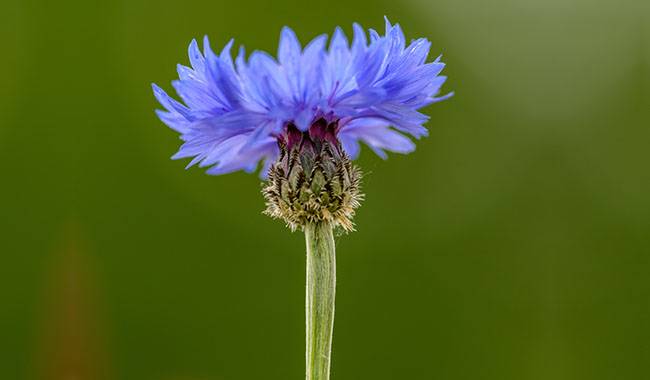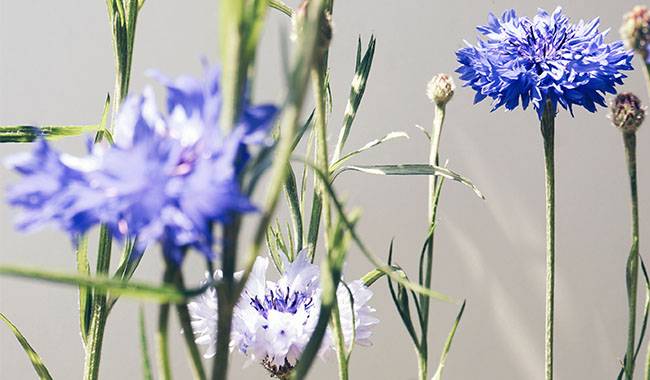
What is cornflower? In this article, we answer your questions about cornflowers.
Recommend you to read “How to grow cornflower: sowing and care“
The blue cornflower lives up to its name as the king of garden cornflowers. Although this plant is annual, no perennial variety can match it for beauty in flowering, and its flower shape and structural characteristics have long been a standard.
Thanks to the efforts of breeders around the world, the pure, rich and surprisingly lovely shades of blue have now expanded into white, pink, red, and mauve, but this has not changed the character of the plant itself in any way.
Cornflower blue is touching, elegant, and very beautiful, and although its wild counterpart can still be found in any field today, it has long been considered a weed.
But the main advantage of this summer flower and its relatives can rightly be called a strikingly simple agricultural technique.
SELECTING CONDITIONS FOR CORNFLOWERS
It is no accident that cornflowers are most often found in open ground. They are hardy plants, intolerant of night frosts and cold fronts, and extremely demanding of light.
To grow annual cornflowers, either the popular and most sought-after blue cornflower or the rarer varieties, you can’t grow them without good light.
Cornflowers need to be in the sunniest spot, open, warm, or even hot.
In the shade of light can only grow annual cornflowers soft, but it is also worse where the flowers are even slightly penumbra, even though it forms a dense clump of the most beautiful leaves there as if covered with a silvery coating.
When planning to plant cornflowers, there is another factor to consider. For this summer flower, it is not the flowers that are crucial, but the light on the leaves. The sun should shine evenly on all the greenery on a fairly small plant.
This is why annual cornflowers are always placed in the foreground (regardless of the height of the species) in combinations planted with perennials, even when mixed with summer plants.
This strategy is ideal to ensure that the bottom of the plant also gets some sunlight.
For the same reason, cornflowers should not be used for dense plantings and fronts but should be carefully selected as partners, often in combination with stunted plants rather than with other larger annuals and perennials.
In order to achieve a productive and extended flowering period, care must be taken to provide cornflower with the best quality soil, cultivation, and medium nutrition.
This annual plant can only produce a large number of large, showy flowers infertile (but not overly humus-rich), well-drained, neutral soils.
Calcareous or excessively acidic soils in which cornflowers grow are best avoided, as are compacted or excessively dry gravelly soils.
For a standard medium to tall blue cornflower variety, the minimum distance these plants are comfortable is about 20inch (0.5m).
Only this distance and the availability of free soil around them will keep the plants from shading each other. There are no special rules for planting annual cornflowers.
BASIC CARE OF CORNFLOWER
The actual care of blue cornflower and other annual species boils down to timely weeding and slight loosening of the soil, which should be done for young plants.
The use of mulching eliminates the need to perform even minimal procedures on these annuals. The only thing worth noting is to be sure to cut back faded shoots in a timely manner so that they can be stimulated to bloom longer and on a larger scale.
Most cornflowers are drought-tolerant plants, especially the most popular blue cornflower, which copes well even when the soil is completely dry for long periods of time.
On the other hand, some of the rarer annual cornflowers, such as mild cornflower and meadow cornflower, do not like drought and need to be kept at least slightly moist.
Starting in June, blue cornflowers begin to bloom heavily and can be watered to maintain bloom rates during particularly long droughts, but watering is still not mandatory at this time.
If you have planted cornflowers in fertile soil, you do not need nutrients. An excess of nutrients in the soil is just as dangerous for cornflowers as a lack of nutrients.
If you wish, you can supplement with half the standard dose of all-mineral fertilizer at the beginning of flowering, but even growing cut flowers of annual cornflowers does not warrant systematic fertilization.
If flowering is severely reduced, the number of flowers decreases and the second wave of flowering is delayed, foliar feeding can be repeated for additional stimulation, but generally, prompt removal of wilted flower stems will allow almost uninterrupted flowering.
Cornflowers flower throughout the summer and into the autumn chill, but are not susceptible to disease or pests, even with prolonged rain.
They are only susceptible to fusarium disease and are only severely infested when grown in beds of annuals.
GROWING CORNFLOWERS
Annual cornflowers can only be propagated by seed. Cornflower is unaffected by frost and cold and can be sown directly into the open soil even when still young.
Early May is the best time to sow, but cornflower seeds can even be sown in April if the soil has warmed up.
The seeds will germinate about a week after sowing. Annual cornflowers can also be planted through seedbeds and subsequently transplanted, or they can be planted directly in situ and subsequently thinned and transplanted.





